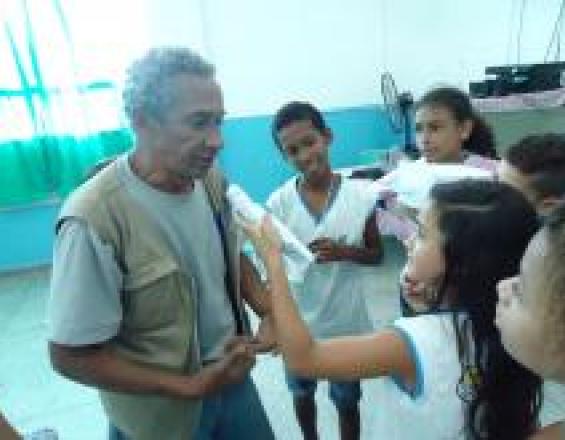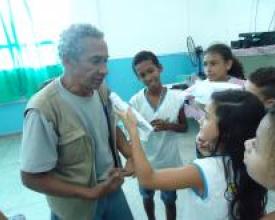Voluntary work in different environmental education activities

Voluntary work has been a good way to building teams and especially engaging local people on environmental efforts in two protected areas. We have benefitted from the need for college and university students to perform extra-curricular activities to complete their courses to attract volunteers. We have also developed a partnership with an NGO to recruit volunteers in urban centres to carry out specific activities. Volunteers are designated for projects in schools, communities and headquarters.
Context
Challenges addressed
lack of awareness, limited budget and staffing These federal protected areas are located in the 12-million-people Rio de Janeiro metropolitan region. Thus, the duty of protecting mangroves and Guanabara bay waters is challenging, and staffing and governmental budget is limited. Local knowledge and awareness about the importance of the area is not widespread. Besides, doing voluntary work is not very common in Brazil.
Location
Process
Summary of the process
Brazil is a country that just recently reached a middle-income level. Public budget for protected areas implementation is still low but due to rising educational opportunities, volunteering culture has become more usual. A legal framework for volunteering has been built in the last two decades. Chico Mendes Biodiversity Conservation Institute (ICMBio) launched its volunteering program in 2009 recognizing the importance of the voluntary work. However, as the protected area headquarter is located in a low-income region and far from urban centres it is difficult to attract people for volunteering. Thus, seizing the opportunity that many college and universities require their students to do extra-curricular activities to get their degree, we have received many students to develop qualified volunteer activities. These activities are important ways to publicize the importance of this protected area and its ecosystems. Moreover, they are a communication channel with the local population. Another component that contributes is promoting partnership with NGOs to organize and finance activities for urban volunteers. Through this initiative, more than raising awareness, we can attract skilled volunteers.
Building Blocks
Institutionalization of the volunteering program
Enabling factors
Lesson learned
Resources
Attracting university and college students
Enabling factors
Lesson learned
Resources
Projects in schools
Enabling factors
Lesson learned
Projects in local communities
Enabling factors
Lesson learned
Open events with environmental activities
Enabling factors
Lesson learned
Creating materials and promoting means of communication
Enabling factors
Lesson learned
Impacts
Through different actions involving volunteers some important impacts have come out: better relation with the local population and more public awareness about the importance of these protected areas for mangrove conservation. These impacts are evidenced by some project results such as: - Contact with 25 schools around these protected areas, comprising around 4,000 students from kindergarten to high school. One of the results of these school activities was the increase of self-esteem and the recognition of mangrove importance among local kids and teenagers that tended to consider the mangroves as dirty and stinky. - Volunteers have also taught students to write and develop their own projects, which resulted in arising young citizenship and improved quality of life for the local people. - Another outcome was engaging urban population through a nature work-day experience involving river banks forest recovery. Besides raising environmental awareness among them, a spillover effect was to attract qualified professionals to voluntarily develop other projects for which there was no public budget.
Beneficiaries
nature, local school students, volunteers, local people, teachers
Story
Brought up in a rural family, Maria Lidia Novaes Correa had to start working early. To support her family, she has worked for more than 15 years cooking in restaurants . When her children grew up and financial need decreased, she decided to go after her dreams: studying and working in the environmental area. She finished high school at age 46 and then took several technical courses. Seven years later she was admitted for two universities, in undergraduate courses in environmental management and biology. At 54, she heard about Chico Mendes Biodiversity Conservation Institute (ICMBio) volunteer program and became interested in being a volunteer in Guapi-Mirim Environmental Protected Area and Guanabara Ecological Station because she had spent her childhood in the region. Even spending two hours to arrive in the office, she worked as a volunteer in these protected areas for about 18 months, once a week, maintaining the plant nurseries and organizing some public events. On her own initiative, she guided and built a worm composting system with the help of another volunteer. Since then, all raw fruit and vegetable skins from the employees and volunteers lunch is put there, and the fertilizer is used in the headquarter’s organic garden, which is an attraction for visitors. One of the maintenance employees learned the importance and how to do the system, and has lectured on the subject. Some months ago Correa was invited by an elementary school in the region to develop a garden with students. This school, one of those where volunteers run the Guapi-Mirim Environmental Protected Area Goes to School Project, is situated in a very poor region. Many of the school students have a fragile family structure. She says that when she arrived many students fled the school in free time, and now a majority of them is very involved with gardening activities. Although Maria Lidia cannot come over every week anymore, we often invite her for collaborating in other projects. According to her, “it was a great opportunity for me to learn more about protected areas and how they are managed. It was also meaningful to realize that my knowledge was important for others and for the environment. The volunteering experience was relevant for my academic studies, too”.




